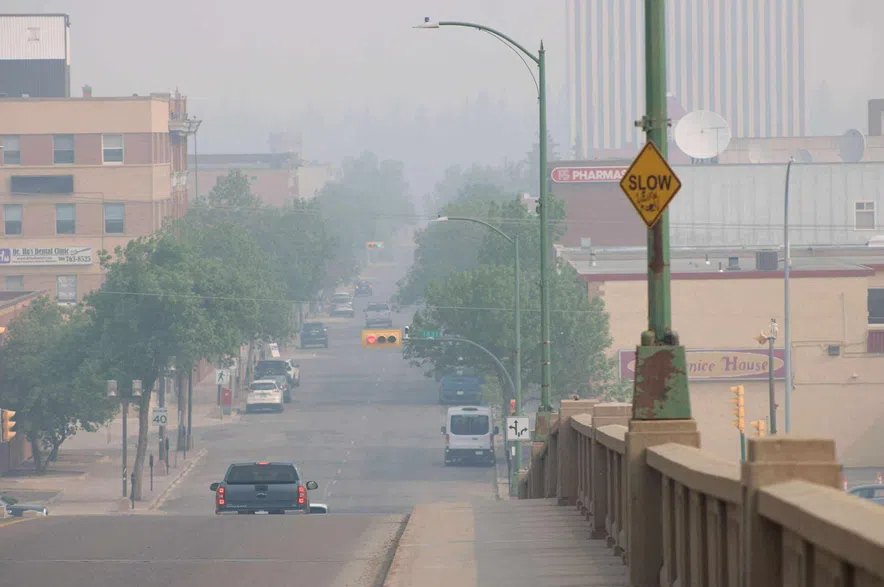Wildfire smoke is lowering the air quality across much of Saskatchewan on Friday.
Environment Canada has issued a special air quality statement across all of central and northern Saskatchewan, warning that smoke from wildfires could create health risks, especially for those spending a lot of time outdoors. The smoke is worst in east-central Saskatchewan, where an air quality warning is in effect.
Read More:
- Crews brace for more hot, dry temperatures in fight against Prairie wildfires
- ‘It doesn’t feel real’: Wildfire leaves East Trout Lake residents devastated
- Regina and Moose Jaw under voluntary water conservation
Saskatoon was covered under the air quality statement, which stretched as far south as Outlook and Davidson.
“Smoke from wildfires in northern Alberta and northern Saskatchewan is expected to periodically cause poor air quality and localized reductions in visibility Friday,” the weather service said in the statement.

Special air quality statements and air quality warnings blanketed much of Saskatchewan on Friday. (Environment Canada)
“The smoke may move into several regions of southern Saskatchewan by Friday afternoon and linger Friday night into Saturday.”
Natalie Hasell, a meteorologist with Environment Canada, said the wind is pushing the smoke south.
“The winds in your forecasts are expected to remain out of the north or northwest,” Hasell said.
“There are fires to your north, northwest, northeast, west, east (and) southeast, so there are very few wind directions that will lead to clear air.”
Hasell said Saskatoon can expect quite a bit of smoke over the next 36 hours.
“The concern is for later today and tonight, and Saturday (Regina) could see a very high risk,” she explained.
“There is a cold front where we have some showers and thunderstorms,” she said. “The thunderstorms will probably be more problematic with respect to fire.”
Hasell said thunderstorms could actually make the situation worse.
“They’re defined by lightning, and lightning strikes don’t just hit right under the storm,” the meteorologist explained.
“They can travel sideways and hit an area that is not going to get any rain and therefore cause more fires.”
Environment Canada said eye, nose and throat irritation are common symptoms from exposure to smoke.
“More serious but less common symptoms include wheezing, chest pains or severe cough,” the statement noted. “If you think you are having a medical emergency, seek immediate medical assistance.”
People 65 and older are more succeptible to health issues caused by smoke, along with pregnant women, infants, young children, those with preexisting or chronic health conditions, and anyone working outdoors. Environment Canada adivsed those groups to “reduce or reschedule strenuous activities outdoors,” and seek medical help for any serious symptoms.
“When indoors, keep windows and doors closed as much as possible,” Environment Canada added.
“If you must spend time outdoors, a well-constructed, well-fitting and properly worn respirator type mask (such as a NIOSH-certified N95 or equivalent respirator) can reduce your exposure to the fine particles in the smoke. Even though exposure may be reduced, there can still be risks to health.”
The latest updates on the air quality alerts can be found on Environment Canada’s website.
The Saskatchewan Public Safety Agency is set to provide an update on the wildfire situation in the province at 1:30 p.m. on Friday. 650 CKOM and 980 CJME will carry the update live.
–with files from 650 CKOM’s Will Mandzuk












